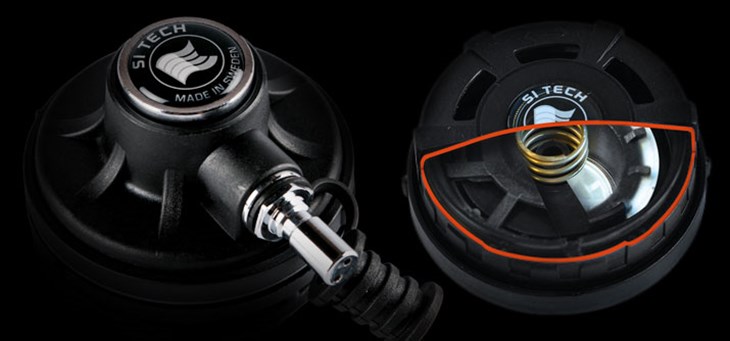Valve philosophy
February 01, 2014
When Stig Insulán (founder of SI TECH) invented the semi-automatic drysuit exhaust valve back in the late sixties he lay the foundation of modern drysuit diving as we know it today! Without his efforts drysuit diving would not have become what it is today.
SI TECH Valves are designed to make your dives pleasant and easy avoiding dangerous pressure gradients between the
suits inner and outer pressure with a maximum resistance of 25 mbar. The focus of the valves is the pressure precision
that make the SI TECH valve superior. This also assures to prevent leakage of insulating gas when set to maximum
pressure for extended surface buoyancy and warmth. The location of the Exhaust Valve at the upper arm ensure an easy
access of internal gas venting when controlling ascent speed and fine adjustment of buoyancy during the dive.
At minimum setting 2 mbar the suit can be evacuated to a minimum of free gas (not gas inherent in the underwear).
HISTORICAL OVERVIEW
Before early 70´s, drysuits was mainly used in commercial and military diving activities. To avoid discomfort created
by squeeze at greater depth, overpressure valves were installed in the ankles, wrists and neck in order to remove
excessive air inflated through the face mask. The inflation of gas also increased the undergarments insulation ability.
This type of drysuit was named constant volume drysuit. The wetsuit was a great improvement and started to be
popular in the early 50´s and drysuits in general became out aged.
Stig Insulán was early involved in wetsuit and general diving gear manufacturing, which he started in 1962. With his
dedication to diving and interest in design he tested the ideas during commercial diving operations. During long dives
under ice in cold water Stig required something better. Stig´s invention of the variable volume drysuit valve, opened
up for a new era of underwater comfort. From extensive diving experience and expertise in regards to diving physiology
a number of criterias was set up:
1. It must act as an automatic overpressure valve, also at maximum setting.
2. It must have feature for manual dumping of insulation gas with occupied hands.
3. It must have a sensitive regulation of internal suit pressure.
4. It must at a given setting maintain internal gas for buoyancy control.
5. It must maintain insulation and flotation gas for prolonged surface time.
6. It must be placed on a location allowing easy gas dumping without
inadvertently deflation. E.G Rising hands for alert call.
7. It must have adequate flow rate to enable easy ascent speed control.
8. It must be removable for checking and service.
9. It must be attached in a Valve Port, preventing leakage if material is compressed.
Also to avoid rip out if tangled.
SI TECH Exhaust Valves are very sensitive to small variations in the difference between internal and external pressure.
The Exhaust Valve is adjustable between 10-200 mm column of water (1/2 to 8 inches) to provide buoyancy variation
with the inherent gas volume.
Easy adjustment of the gas volume in the drysuit is hereby simplified and the drysuit may be used as the only method
of buoyancy control during normal diving conditions (BCD emptied of gas during the dive). This will also support a controlled
ascent, approx. 10-18 meters/minute (35-60 feet/minute), provided the diver’s buoyancy is correctly compensated and the
valve is set properly.
SI TECH drysuit valves are designed to operate as part of a system. A SI TECH inflation valve is designed to provide a
constant flow of gas when the user needs it. The inflation valve will not provide a higher flow rate of gas than the exhaust
valve are able to evacuate, this philosophy has been paramount for SI TECH valve development since day one. Each drysuit
valve are carefully checked and tuned at the factory to perform according to SI TECH standards.
Corporate Articles
- PURPLE Limited edition set
- Precision made in Sweden
- Cold water diving pioneers
- About us
- Dedicated diving personalities
- Benefits of modularity
- Important product information
- Dry Glove Systems covering all needs
- Contact
- Valve philosophy
- The Dynamic QUICK NECK
- ANTARES Support Ring
- At the rudder
- SLÄGGÖ Flex Ring
- ORUST Neck System
- Recall
